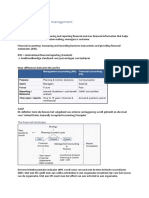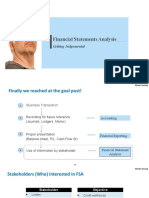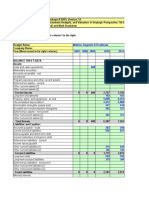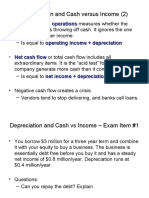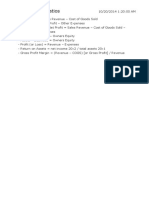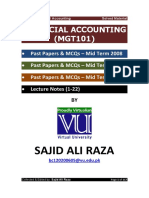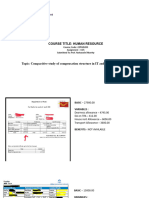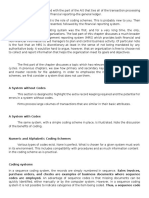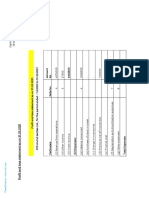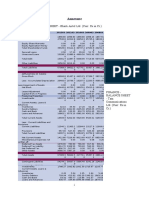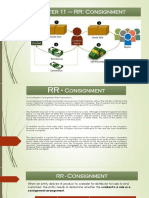Estimating Cash Flows
DCF Valuation
Aswath Damodaran 1
� Steps in Cash Flow Estimation
Estimate the current earnings of the firm
• If looking at cash flows to equity, look at earnings after interest expenses - i.e. net
income
• If looking at cash flows to the firm, look at operating earnings after taxes
Consider how much the firm invested to create future growth
• If the investment is not expensed, it will be categorized as capital expenditures. To
the extent that depreciation provides a cash flow, it will cover some of these
expenditures.
• Increasing working capital needs are also investments for future growth
If looking at cash flows to equity, consider the cash flows from net debt issues
(debt issued - debt repaid)
Aswath Damodaran 2
� Measuring Cash Flows
Cash flows can be measured to
Just Equity Investors
All claimholders in the firm
EBIT (1- tax rate) Net Income Dividends
- ( Capital Expenditures - Depreciation) - (Capital Expenditures - Depreciation) + Stock Buybacks
- Change in non-cash working capital - Change in non-cash Working Capital
= Free Cash Flow to Firm (FCFF) - (Principal Repaid - New Debt Issues)
- Preferred Dividend
Aswath Damodaran 3
� Measuring Cash Flow to the Firm
EBIT ( 1 - tax rate)
- (Capital Expenditures - Depreciation)
- Change in Working Capital
= Cash flow to the firm
Where are the tax savings from interest payments in this cash flow?
Aswath Damodaran 4
� From Reported to Actual Earnings
Operating leases R&D Expenses
Firm’s Comparable - Convert into debt - Convert into asset
history Firms - Adjust operating income - Adjust operating income
Normalize Cleanse operating items of
Earnings - Financial Expenses
- Capital Expenses
- Non-recurring expenses
Measuring Earnings
Update
- Trailing Earnings
- Unofficial numbers
Aswath Damodaran 5
� I. Update Earnings
When valuing companies, we often depend upon financial statements for
inputs on earnings and assets. Annual reports are often outdated and can be
updated by using-
• Trailing 12-month data, constructed from quarterly earnings reports.
• Informal and unofficial news reports, if quarterly reports are unavailable.
Updating makes the most difference for smaller and more volatile firms, as
well as for firms that have undergone significant restructuring.
Time saver: To get a trailing 12-month number, all you need is one 10K and
one 10Q (example third quarter). Use the Year to date numbers from the 10Q:
Trailing 12-month Revenue = Revenues (in last 10K) - Revenues from first 3 quarters
of last year + Revenues from first 3 quarters of this year.
Aswath Damodaran 6
� II. Correcting Accounting Earnings
Make sure that there are no financial expenses mixed in with operating
expenses
• Financial expense: Any commitment that is tax deductible that you have to meet
no matter what your operating results: Failure to meet it leads to loss of control of
the business.
• Example: Operating Leases: While accounting convention treats operating leases
as operating expenses, they are really financial expenses and need to be reclassified
as such. This has no effect on equity earnings but does change the operating
earnings
Make sure that there are no capital expenses mixed in with the operating
expenses
• Capital expense: Any expense that is expected to generate benefits over multiple
periods.
• R & D Adjustment: Since R&D is a capital expenditure (rather than an operating
expense), the operating income has to be adjusted to reflect its treatment.
Aswath Damodaran 7
� The Magnitude of Operating Leases
Chart Title
Aswath Damodaran 8
� Dealing with Operating Lease Expenses
Operating Lease Expenses are treated as operating expenses in computing
operating income. In reality, operating lease expenses should be treated as
financing expenses, with the following adjustments to earnings and capital:
Debt Value of Operating Leases = Present value of Operating Lease
Commitments at the pre-tax cost of debt
When you convert operating leases into debt, you also create an asset to
counter it of exactly the same value.
Adjusted Operating Earnings
Adjusted Operating Earnings = Operating Earnings + Operating Lease Expenses -
Depreciation on Leased Asset
• As an approximation, this works:
Adjusted Operating Earnings = Operating Earnings + Pre-tax cost of Debt * PV of
Operating Leases.
Aswath Damodaran 9
� Operating Leases at The Gap in 2003
The Gap has conventional debt of about $ 1.97 billion on its balance sheet and
its pre-tax cost of debt is about 6%. Its operating lease payments in the 2003
were $978 million and its commitments for the future are below:
Year Commitment (millions) Present Value (at 6%)
1 $899.00 $848.11
2 $846.00 $752.94
3 $738.00 $619.64
4 $598.00 $473.67
5 $477.00 $356.44
6&7 $982.50 each year $1,346.04
Debt Value of leases = $4,396.85 (Also value of leased asset)
Debt outstanding at The Gap = $1,970 m + $4,397 m = $6,367 m
Adjusted Operating Income = Stated OI + OL exp this year - Deprec’n
= $1,012 m + 978 m - 4397 m /7 = $1,362 million (7 year life for assets)
Approximate OI = $1,012 m + $ 4397 m (.06) = $1,276 m
Aswath Damodaran 10
� The Collateral Effects of Treating Operating Leases as Debt
Conventional Accounting Operating Leases Treated as Debt
Income Statement Income Statement
EBIT& Leases = 1,990 EBIT& Leases = 1,990
- Op Leases = 978 - Deprecn: OL= 628
EBIT = 1,012 EBIT = 1,362
Interest expense will rise to reflect the conversion
of operating leases as debt. Net income should
not change.
Balance Sheet Balance Sheet
Off balance sheet (Not shown as debt or as an Asset Liability
asset). Only the conventional debt of $1,970 OL Asset 4397 OL Debt 4397
million shows up on balance sheet Total debt = 4397 + 1970 = $6,367 million
Cost of capital = 8.20%(7350/9320) + 4% Cost of capital = 8.20%(7350/13717) + 4%
(1970/9320) = 7.31% (6367/13717) = 6.25%
Cost of equity for The Gap = 8.20%
After-tax cost of debt = 4%
Market value of equity = 7350
Return on capital = 1012 (1-.35)/(3130+1970) Return on capital = 1362 (1-.35)/(3130+6367)
= 12.90% = 9.30%
Aswath Damodaran 11
� The Magnitude of R&D Expenses
Chart Title
Aswath Damodaran 12
� R&D Expenses: Operating or Capital Expenses
Accounting standards require us to consider R&D as an operating expense
even though it is designed to generate future growth. It is more logical to treat
it as capital expenditures.
To capitalize R&D,
• Specify an amortizable life for R&D (2 - 10 years)
• Collect past R&D expenses for as long as the amortizable life
• Sum up the unamortized R&D over the period. (Thus, if the amortizable life is 5
years, the research asset can be obtained by adding up 1/5th of the R&D expense
from five years ago, 2/5th of the R&D expense from four years ago...:
Aswath Damodaran 13
� Capitalizing R&D Expenses: SAP in 2004
R & D was assumed to have a 5-year life.
Year R&D Expense Unamortized portion Amortization this year
Current 1020.02 1.00 1020.02
-1 993.99 0.80 795.19 € 198.80
-2 909.39 0.60 545.63 € 181.88
-3 898.25 0.40 359.30 € 179.65
-4 969.38 0.20 193.88 € 193.88
-5 744.67 0.00 0.00 € 148.93
Value of research asset = € 2,914 million
Amortization of research asset in 2004 = € 903 million
Increase in Operating Income = 1020 - 903 = € 117 million
Aswath Damodaran 14
� The Effect of Capitalizing R&D: SAP
Conventional Accounting R&D treated as capital expenditure
Income Statement Income Statement
EBIT& R&D = 3045 EBIT& R&D = 3045
- R&D = 1020 - Amort: R&D = 903
EBIT = 2025 EBIT = 2142 (Increase of 117 m)
EBIT (1-t) = 1285 m EBIT (1-t) = 1359 m
Ignored tax benefit = (1020-903)(.3654) = 43
Adjusted EBIT (1-t) = 1359+43 = 1402 m
(Increase of 117 million)
Net Income will also increase by 117 million
Balance Sheet Balance Sheet
Off balance sheet asset. Book value of equity at Asset Liability
3,768 million Euros is understated because R&D Asset 2914 Book Equity +2914
biggest asset is off the books. Total Book Equity = 3768+2914= 6782 mil
Capital Expenditures Capital Expenditures
Conventional net cap ex of 2 million Euros Net Cap ex = 2+ 1020 Ğ 903 = 119 mil
Cash Flows Cash Flows
EBIT (1-t) = 1285 EBIT (1-t) = 1402
- Net Cap Ex = 2 - Net Cap Ex = 119
FCFF = 1283 FCFF = 1283 m
Return on capital = 1285/(3768+530) Return on capital = 1402/(6782+530)
= 29.90% = 19.93%
Aswath Damodaran 15
� III. One-Time and Non-recurring Charges
Assume that you are valuing a firm that is reporting a loss of $ 500 million,
due to a one-time charge of $ 1 billion. What is the earnings you would use in
your valuation?
A loss of $ 500 million
A profit of $ 500 million
Would your answer be any different if the firm had reported one-time losses like
these once every five years?
Yes
No
Aswath Damodaran 16
� IV. Accounting Malfeasance….
Though all firms may be governed by the same accounting standards, the
fidelity that they show to these standards can vary. More aggressive firms will
show higher earnings than more conservative firms.
While you will not be able to catch outright fraud, you should look for
warning signals in financial statements and correct for them:
• Income from unspecified sources - holdings in other businesses that are not
revealed or from special purpose entities.
• Income from asset sales or financial transactions (for a non-financial firm)
• Sudden changes in standard expense items - a big drop in S,G &A or R&D
expenses as a percent of revenues, for instance.
• Frequent accounting restatements
Aswath Damodaran 17
� V. Dealing with Negative or Abnormally Low Earnings
A Framework for Analyzing Companies with Negative or Abnormally Low Earnings
Why are the earnings negative or abnormally low?
Temporary Cyclicality: Life Cycle related Leverage Long-term
Problems Eg. Auto firm reasons: Young Problems: Eg. Operating
in recession firms and firms with An otherwise Problems: Eg. A firm
infrastructure healthy firm with with significant
problems too much debt. production or cost
problems.
Normalize Earnings
If firm’s size has not If firm’s size has changed
changed significantly over time
Value the firm by doing detailed cash
over time
flow forecasts starting with revenues and
reduce or eliminate the problem over
time.:
(a) If problem is structural: Target for
Use firm’s average ROE (if
Average Dollar operating margins of stable firms in the
valuing equity) or average
Earnings (Net Income sector.
ROC (if valuing firm) on current
if Equity and EBIT if (b) If problem is leverage : Target for a
BV of equity (if ROE) or current
Firm made by debt ratio that the firm will be comfortable
BV of capital (if ROC)
the firm over time with by end of period, which could be its
own optimal or the industry average.
(c) If problem is operating : Target for an
industry-average operating margin.
Aswath Damodaran 18
� What tax rate?
The tax rate that you should use in computing the after-tax operating income
should be
The effective tax rate in the financial statements (taxes paid/Taxable income)
The tax rate based upon taxes paid and EBIT (taxes paid/EBIT)
The marginal tax rate for the country in which the company operates
The weighted average marginal tax rate across the countries in which the
company operates
None of the above
Any of the above, as long as you compute your after-tax cost of debt using the
same tax rate
Aswath Damodaran 19
� The Right Tax Rate to Use
The choice really is between the effective and the marginal tax rate. In doing
projections, it is far safer to use the marginal tax rate since the effective tax
rate is really a reflection of the difference between the accounting and the tax
books.
By using the marginal tax rate, we tend to understate the after-tax operating
income in the earlier years, but the after-tax tax operating income is more
accurate in later years
If you choose to use the effective tax rate, adjust the tax rate towards the
marginal tax rate over time.
• While an argument can be made for using a weighted average marginal tax rate, it
is safest to use the marginal tax rate of the country
Aswath Damodaran 20
� A Tax Rate for a Money Losing Firm
Assume that you are trying to estimate the after-tax operating income for a
firm with $ 1 billion in net operating losses carried forward. This firm is
expected to have operating income of $ 500 million each year for the next 3
years, and the marginal tax rate on income for all firms that make money is
40%. Estimate the after-tax operating income each year for the next 3 years.
Year 1 Year 2 Year 3
EBIT 500 500 500
Taxes
EBIT (1-t)
Tax rate
Aswath Damodaran 21
� Net Capital Expenditures
Net capital expenditures represent the difference between capital expenditures
and depreciation. Depreciation is a cash inflow that pays for some or a lot (or
sometimes all of) the capital expenditures.
In general, the net capital expenditures will be a function of how fast a firm is
growing or expecting to grow. High growth firms will have much higher net
capital expenditures than low growth firms.
Assumptions about net capital expenditures can therefore never be made
independently of assumptions about growth in the future.
Aswath Damodaran 22
� Capital expenditures should include
Research and development expenses, once they have been re-categorized as
capital expenses. The adjusted net cap ex will be
Adjusted Net Capital Expenditures = Net Capital Expenditures + Current year’s R&D
expenses - Amortization of Research Asset
Acquisitions of other firms, since these are like capital expenditures. The
adjusted net cap ex will be
Adjusted Net Cap Ex = Net Capital Expenditures + Acquisitions of other firms -
Amortization of such acquisitions
Two caveats:
1. Most firms do not do acquisitions every year. Hence, a normalized measure of
acquisitions (looking at an average over time) should be used
2. The best place to find acquisitions is in the statement of cash flows, usually
categorized under other investment activities
Aswath Damodaran 23
� Cisco’s Acquisitions: 1999
Acquired Method of Acquisition Price Paid
GeoTel Pooling $1,344
Fibex Pooling $318
Sentient Pooling $103
American Internent Purchase $58
Summa Four Purchase $129
Clarity Wireless Purchase $153
Selsius Systems Purchase $134
PipeLinks Purchase $118
Amteva Tech Purchase $159
$2,516
Aswath Damodaran 24
� Cisco’s Net Capital Expenditures in 1999
Cap Expenditures (from statement of CF) = $ 584 mil
- Depreciation (from statement of CF) = $ 486 mil
Net Cap Ex (from statement of CF) = $ 98 mil
+ R & D expense (capitalized) = $ 1,594 mil
- Amortization of R&D = $ 485 mil
+ Acquisitions = $ 2,516 mil
Adjusted Net Capital Expenditures = $3,723 mil
(Amortization was included in the depreciation number)
Aswath Damodaran 25
� Working Capital Investments
In accounting terms, the working capital is the difference between current
assets (inventory, cash and accounts receivable) and current liabilities
(accounts payables, short term debt and debt due within the next year)
A cleaner definition of working capital from a cash flow perspective is the
difference between non-cash current assets (inventory and accounts
receivable) and non-debt current liabilities (accounts payable)
Any investment in this measure of working capital ties up cash. Therefore, any
increases (decreases) in working capital will reduce (increase) cash flows in
that period.
When forecasting future growth, it is important to forecast the effects of such
growth on working capital needs, and building these effects into the cash
flows.
Aswath Damodaran 26
� Working Capital: General Propositions
Changes in non-cash working capital from year to year tend to be volatile. A
far better estimate of non-cash working capital needs, looking forward, can be
estimated by looking at non-cash working capital as a proportion of revenues
Some firms have negative non-cash working capital. Assuming that this will
continue into the future will generate positive cash flows for the firm. While
this is indeed feasible for a period of time, it is not forever. Thus, it is better
that non-cash working capital needs be set to zero, when it is negative.
Aswath Damodaran 27
� Volatile Working Capital?
Amazon Cisco Motorola
Revenues $ 1,640 $12,154 $30,931
Non-cash WC -419 -404 2547
% of Revenues -25.53% -3.32% 8.23%
Change from last year
$ (309) ($700) ($829)
Average: last 3 years
-15.16% -3.16% 8.91%
Average: industry 8.71% -2.71% 7.04%
Assumption in Valuation
WC as % of Revenue 3.00% 0.00% 8.23%
Aswath Damodaran 28
� Dividends and Cash Flows to Equity
In the strictest sense, the only cash flow that an investor will receive from an
equity investment in a publicly traded firm is the dividend that will be paid on
the stock.
Actual dividends, however, are set by the managers of the firm and may be
much lower than the potential dividends (that could have been paid out)
• managers are conservative and try to smooth out dividends
• managers like to hold on to cash to meet unforeseen future contingencies and
investment opportunities
When actual dividends are less than potential dividends, using a model that
focuses only on dividends will under state the true value of the equity in a
firm.
Aswath Damodaran 29
� Measuring Potential Dividends
Some analysts assume that the earnings of a firm represent its potential
dividends. This cannot be true for several reasons:
• Earnings are not cash flows, since there are both non-cash revenues and expenses
in the earnings calculation
• Even if earnings were cash flows, a firm that paid its earnings out as dividends
would not be investing in new assets and thus could not grow
• Valuation models, where earnings are discounted back to the present, will over
estimate the value of the equity in the firm
The potential dividends of a firm are the cash flows left over after the firm has
made any “investments” it needs to make to create future growth and net debt
repayments (debt repayments - new debt issues)
• The common categorization of capital expenditures into discretionary and non-
discretionary loses its basis when there is future growth built into the valuation.
Aswath Damodaran 30
� Estimating Cash Flows: FCFE
Cash flows to Equity for a Levered Firm
Net Income
- (Capital Expenditures - Depreciation)
- Changes in non-cash Working Capital
- (Principal Repayments - New Debt Issues)
= Free Cash flow to Equity
• I have ignored preferred dividends. If preferred stock exist, preferred dividends
will also need to be netted out
Aswath Damodaran 31
� Estimating FCFE when Leverage is Stable
Net Income
- (1- ) (Capital Expenditures - Depreciation)
- (1- ) Working Capital Needs
= Free Cash flow to Equity
= Debt/Capital Ratio
For this firm,
• Proceeds from new debt issues = Principal Repayments + (Capital Expenditures
- Depreciation + Working Capital Needs)
In computing FCFE, the book value debt to capital ratio should be used when
looking back in time but can be replaced with the market value debt to capital
ratio, looking forward.
Aswath Damodaran 32
� Estimating FCFE: Disney
Net Income=$ 1533 Million
Capital spending = $ 1,746 Million
Depreciation per Share = $ 1,134 Million
Increase in non-cash working capital = $ 477 Million
Debt to Capital Ratio = 23.83%
Estimating FCFE (1997):
Net Income $1,533 Mil
- (Cap. Exp - Depr)*(1-DR) $465.90 [(1746-1134)(1-.2383)]
Chg. Working Capital*(1-DR) $363.33 [477(1-.2383)]
= Free CF to Equity $ 704 Million
Dividends Paid $ 345 Million
Aswath Damodaran 33
� FCFE and Leverage: Is this a free lunch?
Debt Ratio and FCFE: Disney
1600
1400
1200
1000
FCFE
800
600
400
200
0
0% 10% 20% 30% 40% 50% 60% 70% 80% 90%
Debt Ratio
Aswath Damodaran 34
� FCFE and Leverage: The Other Shoe Drops
Debt Ratio and Beta
8.00
7.00
6.00
5.00
Beta
4.00
3.00
2.00
1.00
0.00
0% 10% 20% 30% 40% 50% 60% 70% 80% 90%
Debt Ratio
Aswath Damodaran 35
� Leverage, FCFE and Value
In a discounted cash flow model, increasing the debt/equity ratio will
generally increase the expected free cash flows to equity investors over future
time periods and also the cost of equity applied in discounting these cash
flows. Which of the following statements relating leverage to value would you
subscribe to?
Increasing leverage will increase value because the cash flow effects will
dominate the discount rate effects
Increasing leverage will decrease value because the risk effect will be greater
than the cash flow effects
Increasing leverage will not affect value because the risk effect will exactly
offset the cash flow effect
Any of the above, depending upon what company you are looking at and
where it is in terms of current leverage
Aswath Damodaran 36














